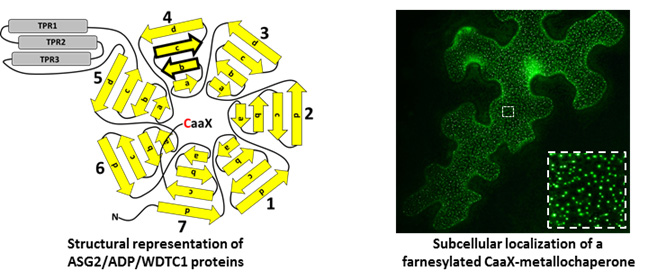Protein Prenylation
Our topics :
Protein prenylation is a post-translational process that consists in the attachment of a prenyl moiety to the specific C-terminal extremity of CaaX-proteins. This irreversible modification promotes membrane anchoring, protein-protein interaction or enzymatic activity modulation. In plant, this reaction is catalysed by the prenyltransferases involving the PLP/GGB or PLP/ERA1 protein dimers. PLP/GGB adds specifically geranlygeranyl moieties whereas PLP/ERA1 adds farnesyl moieties.
Our team investigates the role of the protein farnesylation system in the plant model Arabidopsis. By studying the era1 mutant, we identified several processes related to seed development, C/N balance in plant and root architecture that engage farnesylated CaaX-proteins.Farnesylated CaaX-proteins and seed development:
We recently showed that the Arabidopsis mutant era1 produces numerous ovules but few develop into seed. Nevertheless, era1 seeds are larger, display altered lipid contents and a two-fold increased accumulation of proteins compared to wild-type plants. These original features make it a model for studying the quality of seeds of agronomic interest. Investigating seed maturation in era1 reveals that several steps are altered in this mutant. Lipid modifications may be attributed to ASG2, a farnesylated CaaX-protein homolog to the anti-obesity animal factor ADP/WDTC1. Ovule abortion may be attributed to farnesylated CaaX-metallochaperones. Functional characterization of CaaX-proteins is undergoing and for this purpose, we developed specific approaches:
- in vivo tagging and capture of plant prenylated CaaX-proteins
- in vitro prenylation of CaaX-proteins
- subcellular localization of prenylated CaaX-proteins

Protein farnesylation in environmental global changes:
Considering the environmental changes in which the increase in atmospheric CO2 tends to decrease the nutritional qualities of plants (mainly in protein and mineral salts), we aim to identify new genetic factors influencing the allocation of nitrogen and carbon resources in the seed reserves of proteo-oleaginous crops. The era1 mutant was initially characterized for its enhanced resistance to drought, which results from a constitutive reduction of stomatal opening, limiting water loss in leaves but reducing incoming CO2. We are characterizing the metabolic activity of the era1 mutant in different growing conditions: increase of atmospheric CO2 or nitrogen starvation. The efficiency of photosynthesis and the primary metabolic production (sugars, amino acids) in leaves, as well as protein and lipid contents in seeds, are currently evaluated. In parallel, a transcriptomic analysis, comparing the expression of genes in era1 and WT leaves will offer a global map of the transcriptional modifications in this mutant under the different growth conditions; the nitrogen and carbon assimilation pathways will thus be recontextualized throughout their foliar metabolisms. The genes encoding CaaX-proteins, exhibiting significant expression level changes, will be functionally characterized by reverse genetics and the impact of farnesylation on the activity of these CaaX-proteins will be evaluated.
Because era1 mutant develops interesting agronomic traits, deciphering the role of CaaX-proteins may be a promising approach for the future selection of species with agronomic interests.Group leader
Dr Eric Ducos
email : eric.ducos@univ-tours.fr
